Top +10 ManageEngine Alternatives in '24: 4k+ Reviews Analyzed
Organizations navigate the complexities of managing their networks, it’s essential to explore a range of options to find the best fit for their needs.
ManageEngine OpManager delivers a robust network monitoring and management software designed to offer insights and control over IT infrastructure for companies of all sizes. While ManageEngine has established itself as a player in this space, there are several alternative options available, each offering its own set of features and benefits.
In this guide, we identified top ManageEngine competitors that address these shortcomings which may be attractive for users who are looking to buy a new solution or switch from ManageEngine OpManager to another solution.
| Vendors | Network Monitoring | Endpoint Management | Network Security Policy Management |
|---|---|---|---|
| ManageEngine | OpManager | Endpoint Central | Firewall Analyzer |
| IBM | IBM SevOne | IBM Security MaaS360 | IBM Security MaaS360 |
| Cisco | ThousandEyes | Cisco Secure Endpoint | DNA Center |
| SolarWinds | Network Performance Monitor | ✅ | Network Configuration Manager |
| Atera** | ✅ | ❌ | ✅ |
All these vendors offer a range of enterprise IT management products.
If you’re seeking an alternative to ManageEngine’s platform, consider exploring alternatives such as IBM, Cisco, and SolarWinds for a comparable suite of tools. For:
- Unified Endpoint Management (UEM) capabilities, you can refer to this analysis: Top 10 Endpoint Management Software in 2024: 12K+ Reviews.
- Firewall analysis, you might find this resource useful: Firewall Management: Challenges and 8 Best Practices in 2024.
- Low code solutions, this guide could be insightful: Top 7 Low-Code Software in 2024: Vendor Selection Guide.
ManageEngine OpManager Overview
OpManager is a network monitoring platform crafted to oversee routers, switches, firewalls, servers, virtual machines, and additional network components for both fault and performance concerns. Here’s an overview of its pros and cons:
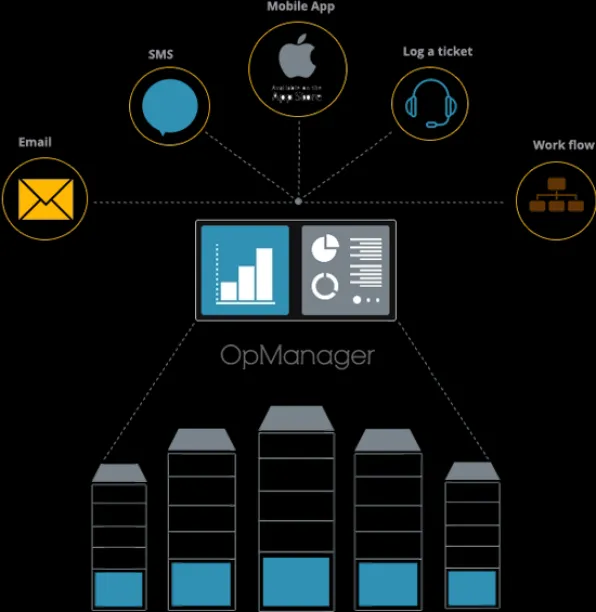
Source: ManageEngine Website.1
Pros:
- Performance metrics: With over 2000 performance metrics, OpManager provides insights into network performance through intuitive dashboards, instant alerts, and intelligent reporting.
- Alerting and automation: ManageEngine OpManager keeps users informed about network issues in real-time through email and SMS alerts and offers IT workflow automation to streamline troubleshooting and maintenance tasks.
- Root cause analysis: The platform facilitates rapid fault identification through centralized visualization, analysis, and correlation of monitor performance.
- Customizable reporting: ManageEngine OpManager offers over 100 customizable reports for network availability, usage trends, and performance analysis, enhancing visibility and decision-making.
Cons:
- Complexity: OpManager may lead to complexity in setup and configuration, requiring adequate time and expertise for implementation.
- Integration challenges: Integrating OpManager with existing IT infrastructure and third-party tools may pose challenges, particularly in heterogeneous environments with diverse technologies and protocols.
Source: G2 2
Table 1. ManageEngine competitors comparison
| Vendors | Reviews* | Free Trial | Employees** | Price |
|---|---|---|---|---|
| AKIPS | 5/5 based on 4 reviews | ✅ for 30-days | 11-50 | Not shared publicly |
| ManageEngine OpManager | 4.7/5 based on 92 reviews | ✅ for 30-days | 201-500 | Starting $795 /month with Annual subscription fee for 50 Devices
Pack with 2 Users
|
| Auvik | 4.6/5 based on 266 reviews | ✅ for 14-days | 201-500 | Not shared publicly |
| Paessler PRTG | 4.6/5 based on 279 reviews | ✅ for 30-days | 201-500 | Starting €1,649 |
| Dynatrace | 4.5/5 based on 1,242 reviews | ✅ for 15-days | 1,000-5,000 | Full-Stack Monitoring: $0.08 per hour for an 8 GB host. Infrastructure Monitoring: $0.04 per hour Kubernetes |
| LogicMonitor | 4.5/5 based on 612 reviews | ✅ for 15-days | 1,000-5,000 | Not shared publicly. |
| Solarwinds NPM | 4.5/5 based on 290 reviews | ✅ for 30-days | 1,000-5,000 | Not shared publicly. |
| Cisco ThousandEyes | 4.5/5 based on 77 reviews | ✅ for 15-days | 501-1,000 | Not shared publicly |
| LiveAction LiveNX | 4.4/5 based on 6 reviews | ✅ for 14-days | 201-500 | Not shared publicly. |
| Datadog | 4.3/5 based on 464 reviews | ✅ for 14-days | 1,000-5,000 | Starting $15 /month per host |
| New Relic | 4.3/5 based on 428 reviews | N/A | 51-200 | Not shared publicly |
Transparency statement: Vendors are ranked according to their average ratings, except sponsors which receive links.
Selection Criteria
We narrowed down ManageEngine OpManager alternatives using three main factors:
- Number of employees: We looked at vendors with 11+ employees on LinkedIn.
- Number of user reviews: We gave preference to solutions with user reviews from popular B2B review websites (such as G2 and Capterra), as it indicates a proven track record based on user experiences.
Evaluation of ManageEngine Alternatives
AKIPS
AKIPS is a network monitoring solution known for its visibility and real-time analytics, offering insights into network performance, traffic, and devices.
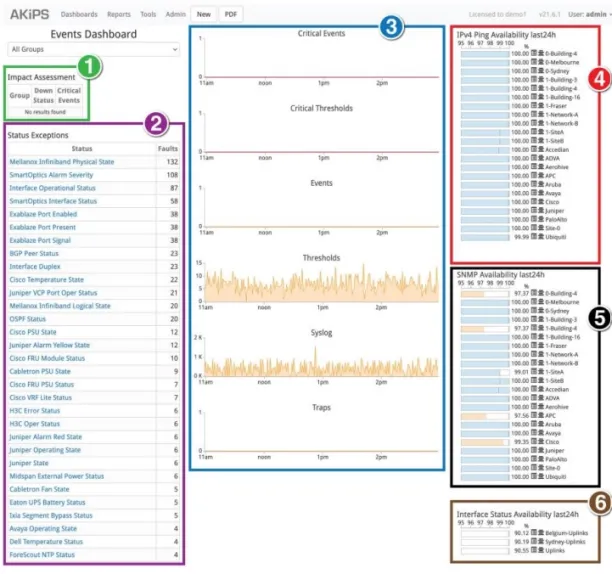
Source: AKIPS, Navigating the events dashboard 3
Key Features:
- Real-time analytics: Provides instant data on network performance, helping in swift decision-making.
- Historical data analysis: Allows users to review past network performance data for trend analysis and long-term planning.
Pros:
- Enhanced operational awareness: AKIPS’s real-time analytics offer clear insights into network performance and traffic, which boosts the effectiveness of monitoring operations.
- Capacity for large data volumes: The platform can manage and analyze large datasets, making it suitable for extensive network environments.
Cons:
- Complex user experience: Users new to AKIPS might find the system complex due to its depth of data and analytics capabilities.
- Limited customization: The platform offers fewer customization options than some of its competitors, which could be a drawback for some organizations.
Source: G2 4
Read: In-Depth Look at AKIPS Network Monitoring Software in 2024
Auvik
Auvik is a network monitoring and management solution focused on simplifying network infrastructure visibility and management, providing insights into network traffic, devices, and configurations.
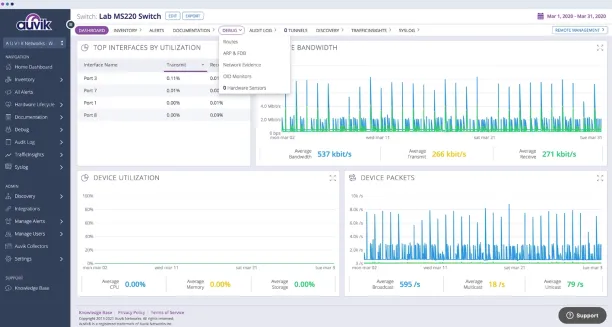
Source: Auvik Network Monitoring5
Key Features:
- Internet and cloud visibility: Offers detailed visibility into cloud and internet services, crucial for managing modern network infrastructures.
- Path visualization and analysis: Provides graphical representations of network paths, aiding in troubleshooting and optimization.
- DNS monitoring: Monitors DNS health and performance, preventing and quickly resolving DNS-related issues.
Pros:
- Simplified network management: Auvik’s focus on simplifying network management makes it efficient for quickly identifying and resolving network issues.
- Enhanced visibility: Detailed visibility into internet and cloud services is important for modern networks that rely heavily on these services.
Cons:
- Subscription costs: While offering wide range of features, the cost can be high, especially for smaller organizations.
- Complex setup: The initial setup and configuration can be complex and time-consuming, requiring technical expertise.
Source: G2 6
Paessler PRTG
PRTG Network Monitor by Paessler is a network monitoring solution offering customizable dashboards, alerting, and reporting for network infrastructure, servers, and applications.
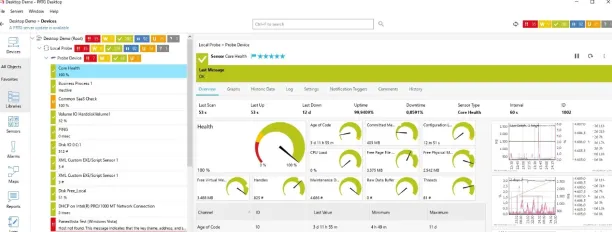
Source: Paessler PRTG 7
Key Features:
- Sensor-based monitoring: Utilizes over 250 pre-configured sensor types to monitor different aspects of network and server performance.
- Customizable dashboards: Allows users to create tailored views of their network’s performance metrics, enhancing the monitoring experience.
Pros:
- Sensor monitoring: The vast array of sensors makes it highly versatile, suitable for diverse monitoring needs.
- User-centric design: Customizable dashboards empower users to focus on key metrics that matter most to their operations.
Cons:
- Complex pricing model: The sensor-based pricing model can become costly as network complexity and monitoring needs increase.
- Resource intensiveness: The software may require significant system resources, particularly in larger setups.
Source: G2 8
Dynatrace
Dynatrace provides AI-powered monitoring solutions that offer visibility into application performance and user experience across cloud environments and hybrid infrastructures.
Key Features:
- AI-powered monitoring: Utilizes artificial intelligence to automate the monitoring process, reducing manual workload and increasing accuracy.
- Full-stack observability: Provides a view of the entire IT infrastructure, from applications to databases, ensuring no component is overlooked.
Pros:
- Intelligent automation: Dynatrace’s AI-driven approach speeds up problem detection and resolution, enhancing operational efficiency.
- Infrastructure insights: With full-stack observability, administrators gain a holistic view of system health, which helps in pinpointing issues across the entire technology stack.
Cons:
- Complex setup: The capabilities of the software may require a complex setup process, which could be a barrier for less technical users.
Source: G29
LogicMonitor
LogicMonitor is a cloud-based monitoring platform that offers automated discovery, monitoring, and alerting for networks, infrastructure, and applications, providing scalability and flexibility.
Key features:
- Automated device discovery: Automatically identifies and maps devices connected to a network, streamlining network management.
- Cloud infrastructure monitoring: Provides tools to monitor the health and performance of cloud-based infrastructure, supporting both private and public cloud environments.
Pros:
- Enhanced scalability: The cloud-based nature of LogicMonitor allows for easy scaling to accommodate growing business needs.
- Operational ease: Automation in discovery and monitoring reduces the manual efforts required, saving time and reducing errors.
Cons:
- Dependency on internet connectivity: Being cloud-based, its performance is highly dependent on internet connectivity, which could be a limitation in areas with unstable connections.
- Learning curve: Some users might find the wealth of features overwhelming, necessitating a period of adjustment and learning.
Source: G210
SolarWinds NPM
SolarWinds Network Performance Monitor (NPM) offer a suite of network monitoring and management solutions, providing network visibility and control.
Key Features:
- Network Performance Monitor (NPM): Delivers precise and comprehensive monitoring for network performance.
Pros:
- Network control: Provides extensive tools for monitoring and managing network performance and configurations, offering complete control over the network environment.
- Issue resolution: Enables early detection and resolution of network issues, minimizing downtime and enhancing network reliability.
Cons :
- Complexity in use: Due to its comprehensive features, the learning curve can be steep for new users.
- Cost considerations: The full suite of tools can be costly, particularly for small to mid-sized businesses.
Source: G211
Cisco ThousandEyes
Cisco ThousandEyes offers cloud-based network monitoring solutions that provide insights into network performance, connectivity, and internet traffic, helping organizations optimize digital experiences.
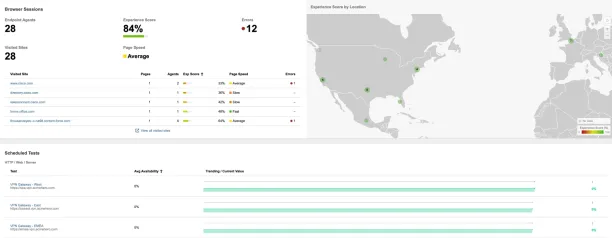
Source: Cisco ThousandEyes 12
Key Features:
- Cloud-based network monitoring: Delivers detailed insights into network performance and health from a cloud-based platform.
- Error and log analysis: Provides advanced capabilities for diagnosing issues through detailed error logs and analysis.
- Cloud infrastructure visibility: Offers visibility into cloud networks, essential for managing modern IT environments.
Pros:
- Digital experience optimization: Cisco ThousandEyes helps organizations optimize user experiences by providing critical insights into connectivity and performance issues.
- Scalability and accessibility: Being cloud-based, it easily scales and is accessible from anywhere, simplifying management for global operations.
Cons:
- Dependency on cloud: Reliance on a cloud platform might raise concerns regarding data security and connectivity issues.
- Pricing model: The pricing can be complex and might not be cost-effective for smaller organizations with less extensive monitoring needs.
Source:G2 13
LiveNX
LiveNX offers network performance monitoring and visualization tools, enabling network engineers to identify and troubleshoot issues quickly through its intuitive interface.
Key Features:
- QoS monitoring and management: Helps in optimizing and managing the quality of service of network traffic, crucial for maintaining performance standards.
- WAN optimization: Enhances wide area network (WAN) efficiency, reducing latency and improving connection quality.
- Packet capture: Allows for detailed traffic analysis by capturing and analyzing network packets.
Pros:
- Rapid Issue resolution: LiveNX’s tools enable quick identification and troubleshooting of network issues, reducing downtime.
- Intuitive user interface: The user-friendly interface simplifies the process of network monitoring, making it accessible even for users with limited technical expertise.
Cons:
- Resource intensity: The features may demand significant system resources, potentially impacting the performance of less capable hardware.
- Specialized training needed: To fully leverage the tool’s capabilities, specific training may be required, adding to the operational cost.
Source: G214
Atera
Atera is an all-in-one remote monitoring and management (RMM) platform that includes network monitoring features, allowing MSPs and IT professionals to monitor network health, performance, and security from a single dashboard
- Integrated RMM platform: Combines remote monitoring and management in a single solution.
- Network monitoring: Enables continuous health checks of network performance and security.
- Patch management and automation: Automates the process of updating and patching systems, ensuring up-to-date security and performance.
Pros:
- All-in-one solution: Provides a comprehensive toolset that covers most IT management needs from a single dashboard, simplifying operations.
- Security measures: Automated patch management helps keep systems secure without manual intervention, reducing vulnerabilities.
Cons:
- Suitability for larger enterprises: May lack some of the advanced features needed by very large organizations.
- Learning and adaptation: While designed to be user-friendly, the breadth of tools available might require a learning period for optimal use.
Source: Capterra15
Datadog
Datadog provides cloud-scale monitoring and analytics platform, offering visibility into infrastructure, applications, logs, and more, with integrations for network monitoring and troubleshooting.
Key Features:
- Log management: Comprehensive tools for managing and analyzing logs to enhance system diagnostics.
- Integration with cloud platforms and popular services: The software works with various cloud services, enhancing monitoring capabilities.
Pros:
- Integration capabilities: The ability to integrate with a wide range of services and platforms makes it highly adaptable to different IT environments.
- Advanced analytics: Offers powerful analytical tools that help in deep analysis and visualization of data across systems.
Cons:
- Complex interface: The interface can be complex due to the depth of features and data available, which may require more time to master.
Source: Capterra16
New Relic
While primarily known for application performance monitoring, New Relic also offers infrastructure monitoring capabilities, providing visibility into the performance and health of servers and network infrastructure.
Key Features:
- Application performance monitoring: Focuses on monitoring and optimizing the performance of applications.
- Infrastructure monitoring: Extends capabilities to server and network infrastructure, providing a holistic view of IT health.
Pros:
- Performance insights: Offers detailed insights into application and infrastructure performance, aiding in proactive management and optimization.
- Flexible integration: Integrates well with a variety of platforms and tools, enhancing its utility in diverse environments.
Cons:
- Complex interface: Users may find the interface and vast array of features challenging to navigate.
Source: G2 17
Further Reading
- Top 8 Network Observability Tools in ’24: 2k+ Reviews Analyzed
- Top 7 Free Network Monitoring Tools based on 1,000+ Reviews in 2024
- Top 10 Network Monitoring Software based on 3,000+ Reviews
- Top 5 Network Performance Monitoring Tools in 2024
External Resources
- 1. “End to end network monitoring”. ManageEngine OpManager. Accessed: April/15/2024.
- 2. “OpManager Pricing, Alternatives & More 2024.” G2. Accessed April 17, 2024.
- 3. ”AKIPS User Guide“. Retrieved April 17, 2024.
- 4. ”AKIPS Reviews“. G2. Mar 15, 2023. Retrieved April 17, 2024.
- 5. “Auvik”. Accessed April 17, 2024.
- 6. “Pros and Cons of Auvik“. G2, Accessed April 17, 2024.
- 7. “Paessler PRTG”. Accessed 17 April 2024.
- 8. “A user review on Paessler PRTG Network Monitor”. G2, Accessed 17 April 2024.
- 9. ”Dynatrace Reviews“. G2. May 05, 2023. Retrieved April 17, 2024.
- 10. “LogicMonitor Reviews 2024: Details, Pricing & Features.” G2. Accessed 17 April 2024.
- 11. “A Review of SolarWinds Network Performance Monitor by Waqas S.”. G2 Feb 20, 2023. Retrieved April 17, 2024
- 12. “Cisco ThousandEyes Website”. April 17, 2024
- 13. “A Review of Datadog by
Mario Alfonso R.”. G2 March 02, 2023. Retrieved April 17, 2024 - 14. “LiveNX Reviews 2024: Details, Pricing & Features.” G2. Accessed 17 April 2024.
- 15. “Atera Pricing, Alternatives & More 2024.” Capterra. Accessed April 17, 2024.
- 16. “Datadog Pricing, Alternatives & More 2024.” Capterra. Accessed April 17, 2024.
- 17. “New Relic Alternatives & More 2024.” G2. Accessed April 17, 2024.

Cem is the principal analyst at AIMultiple since 2017. AIMultiple informs hundreds of thousands of businesses (as per Similarweb) including 60% of Fortune 500 every month.
Cem's work has been cited by leading global publications including Business Insider, Forbes, Washington Post, global firms like Deloitte, HPE, NGOs like World Economic Forum and supranational organizations like European Commission. You can see more reputable companies and media that referenced AIMultiple.
Throughout his career, Cem served as a tech consultant, tech buyer and tech entrepreneur. He advised enterprises on their technology decisions at McKinsey & Company and Altman Solon for more than a decade. He also published a McKinsey report on digitalization.
He led technology strategy and procurement of a telco while reporting to the CEO. He has also led commercial growth of deep tech company Hypatos that reached a 7 digit annual recurring revenue and a 9 digit valuation from 0 within 2 years. Cem's work in Hypatos was covered by leading technology publications like TechCrunch and Business Insider.
Cem regularly speaks at international technology conferences. He graduated from Bogazici University as a computer engineer and holds an MBA from Columbia Business School.
Sources:
AIMultiple.com Traffic Analytics, Ranking & Audience, Similarweb.
Why Microsoft, IBM, and Google Are Ramping up Efforts on AI Ethics, Business Insider.
Microsoft invests $1 billion in OpenAI to pursue artificial intelligence that’s smarter than we are, Washington Post.
Data management barriers to AI success, Deloitte.
Empowering AI Leadership: AI C-Suite Toolkit, World Economic Forum.
Science, Research and Innovation Performance of the EU, European Commission.
Public-sector digitization: The trillion-dollar challenge, McKinsey & Company.
Hypatos gets $11.8M for a deep learning approach to document processing, TechCrunch.
We got an exclusive look at the pitch deck AI startup Hypatos used to raise $11 million, Business Insider.
To stay up-to-date on B2B tech & accelerate your enterprise:
Follow on
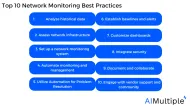

Comments
Your email address will not be published. All fields are required.